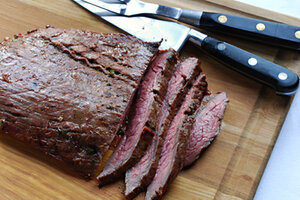Tender and flavorful: Grilled Asian flank steak
Dry brining flank steak tenderizes it. Marinating steak in ginger, garlic, cilantro, lime juice, scallions, hot sauce, and more makes it a show-stopping main course.

Grilled Asian flank steak is an affordable cut of meat, takes well to marinades, and is as tender as it is flavorful.
Blue Kitchen
I use the word flavorful a lot here, I know. Sometimes, I think I should reserve it for flank steak. Before going any further, let me share my own idea of what flavorful means. It’s not a one-note taste bud bomb, like a buffalo wing or a lemon wedge. To me, flavorful means engaging multiple corners of the palate at once, bringing layer after layer of tastes and combining them beautifully. If done right, flavorful means stopping conversation at the dinner table with the first bite. Which is what the flank steak pictured here did on Labor Day.
Flank steak makes such feats easy. Not only is it one of the meatiest tasting cuts of beef on its own – it takes well to marinating. It’s usually one of the more affordable cuts, too, which makes me wonder why it isn’t more popular.
Actually, I know why. Flank steak, cut from hardworking abdominal muscles with a pronounced grain of long muscle fibers, has a reputation for being tough. And it can be, if overcooked or carved improperly. But cooked to medium-rare or just barely medium and then sliced thin across the grain, it’s plenty tender. And, well, flavorful.
Still, a recent comment by a reader on an old post about tenderizing notoriously chewy (but also delicious) lamb shoulder chops with kosher salt had me wondering if the same technique would make flank steak even more tender. The technique is called dry brining. Essentially, you coat the meat with a generous layer of coarse kosher salt and let it sit for a while. Then you rinse the salt off. I hear alarm bells going off everywhere right now: “But that will suck all the juices out of the meat!” It does, at first. Then the juices are drawn back into the meat, along with the salt, changing the protein cell structure and tenderizing the steak (or lamb or pork or…).
It also flavors the meat, so don’t add any more salt before cooking – and don't use particularly salty ingredients in your marinade. Also, don’t use table salt for dry brining. It’s too fine, and too much will be absorbed by the meat. You certainly can make this recipe without the dry brining step. Just season the steak with a little salt before putting it on the grill. But it really did make the meat incredibly tender.
The marinade is a mash-up of a number of recipes I’ve seen, plus some of my own ideas. It’s an international mash-up, too, of ingredients that not only cross various Asian boundaries, but find their ways to other continents. One, the wildly (and deservedly) popular Sriracha hot sauce, is actually an American product created in the suburbs of Los Angeles by a Chinese-Vietnamese immigrant, David Tran. For as many big flavors as you’ll see on the ingredients list – and for as fragrant as the marinade is when you’ve mixed it together – the resulting flavor on the grilled steak is pleasantly restrained. It doesn’t overpower the rich meaty flavor of the steak; it just makes it – OK, last time for this post – more flavorful.
Grilled Asian Flank Steak
Serves 4 to 6
1 1/2-pound flank steak
kosher salt (do not use table salt)
For marinade:
2 tablespoons finely chopped fresh cilantro
1 tablespoon minced fresh ginger
2 tablespoons finely chopped scallions (about 1)
1 jalapeño pepper, finely chopped (see Kitchen Notes)
2 large cloves garlic, minced
zest of 1 lime
1 tablespoon brown sugar
1 tablespoon lime juice
1 tablespoon fish sauce (available in Asian markets and many supermarkets)
2 teaspoons Sriracha (or other hot sauce)
2 tablespoons olive oil
Pat steak dry with paper towels. Season generously on both sides with kosher salt and wrap tightly in plastic wrap. Let it rest on counter for one hour.
Meanwhile, make marinade. Combine all ingredients in a medium bowl and set aside. After steak has been coated with salt for one hour, unwrap it and rinse thoroughly under cold running water. Pat dry with paper towels and place in a large zippered plastic bag. Add marinade to bag, being careful to coat steak on both sides. Seal bag, forcing out most of the air inside and, manipulating bag from the outside, work rub marinade against surfaces of the steak. Refrigerate at least six hours and preferably overnight.
Grill steak. About half an hour before the grill is ready for cooking, remove steak from fridge to bring it to room temperature. Prepare grill for direct grilling and medium-high heat. Remove steak from zippered bag and scrape off excess marinade (I used the back edge of a table knife). Discard marinade.
Brush grill grate with a little oil and place steak directly over coals (or gas heat source). Close grill and cook for about four minutes. Turn and cook other side for about four minutes, with grill lid closed. If first side isn’t sufficiently browned, flip and cook for maybe another minute. Steak should be medium-rare to medium at this point. Do not cook more than than 10 minutes; when flank steak is overcooked (aka well-done) it becomes tough.
Transfer to cutting board or platter and tent with foil. Let steak rest for five minutes, then slice into quarter- to half-inch thick slices – the thinner, the better –across the grain. Serve.
Kitchen Notes
Don’t fear the heat. Yes, the recipe calls for an entire jalapeño pepper, seeds and all, and two teaspoons of hot sauce. But most of this gets scraped off after the steak is done marinating. The heat was barely noticeable.

